Abstract
1. The effect of the different phases of the menstrual cycle on skeletal muscle strength, contractile properties and fatiguability was investigated in ten young, healthy females. Results were compared with a similar group on the combined (non-phasic) oral contraceptive pill (OC). Cycle phases were divided into the early and mid-follicular, mid-cycle (ovulatory) and mid- and late luteal. Cycle phases were estimated from the first day of the menstrual bleed. 2. Subjects were studied weekly through two complete cycles. Measurements included quadriceps and handgrip maximum voluntary isometric force and the relaxation times, force-frequency relationship and fatigue index of the quadriceps during percutaneous stimulation at a range of frequencies from 1 to 100 Hz. 3. In the women not taking the OC there was a significant increase of about 11% in quadriceps and handgrip strength at mid-cycle compared with both the follicular and luteal phases. Accompanying the increases in strength there was a significant slowing of relaxation and increase in fatiguability at mid-cycle. No changes in any parameter were found in the women taking the OC. 4. The changes in muscle function at mid-cycle may be due to the increase in oestrogen that occurs prior to ovulation.
Full text
PDF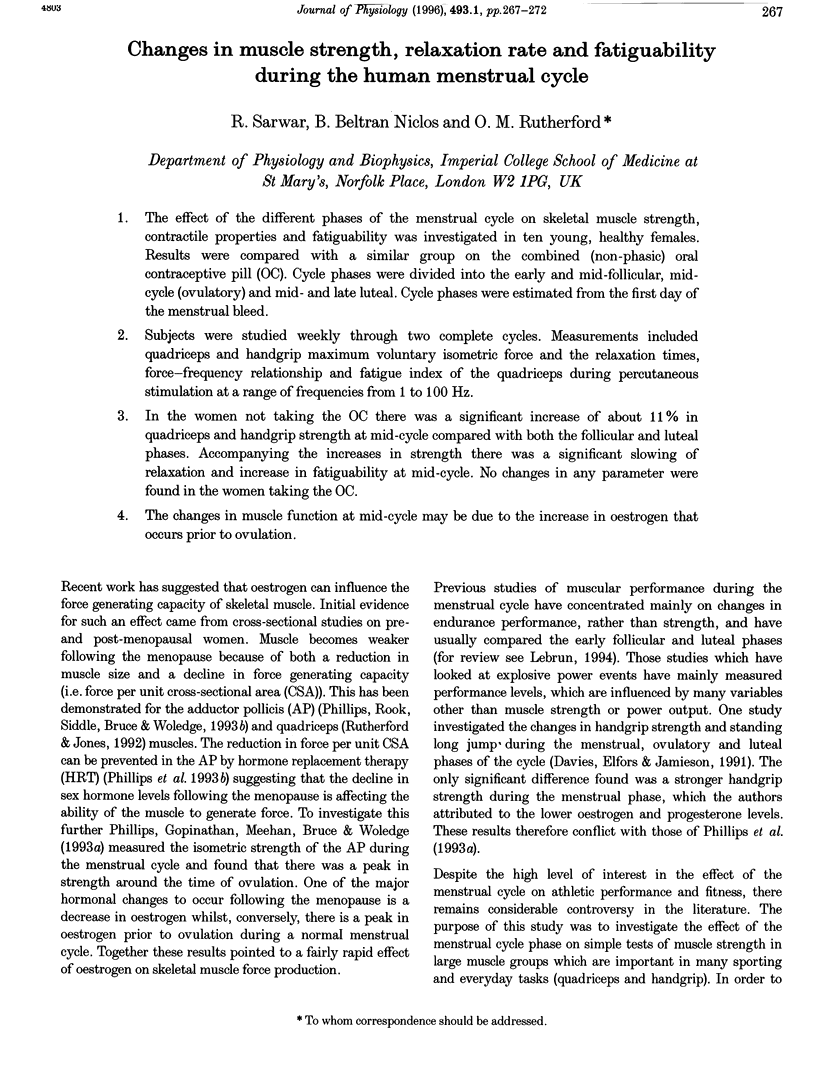
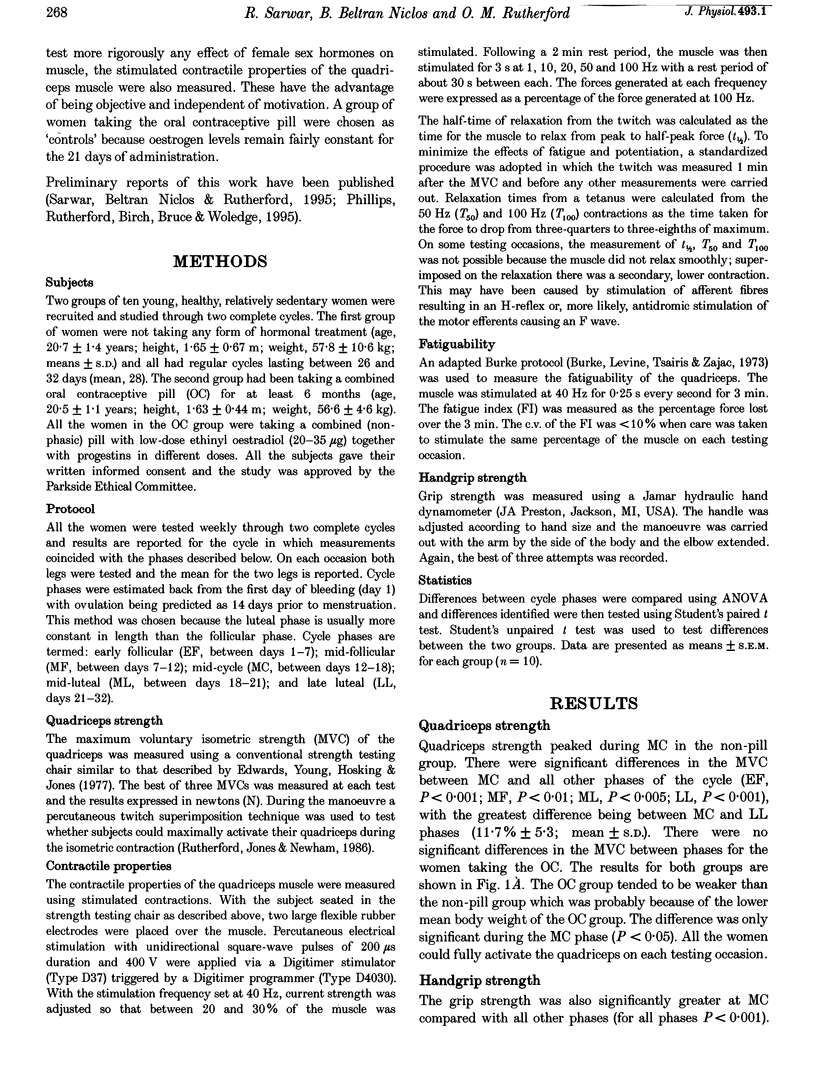
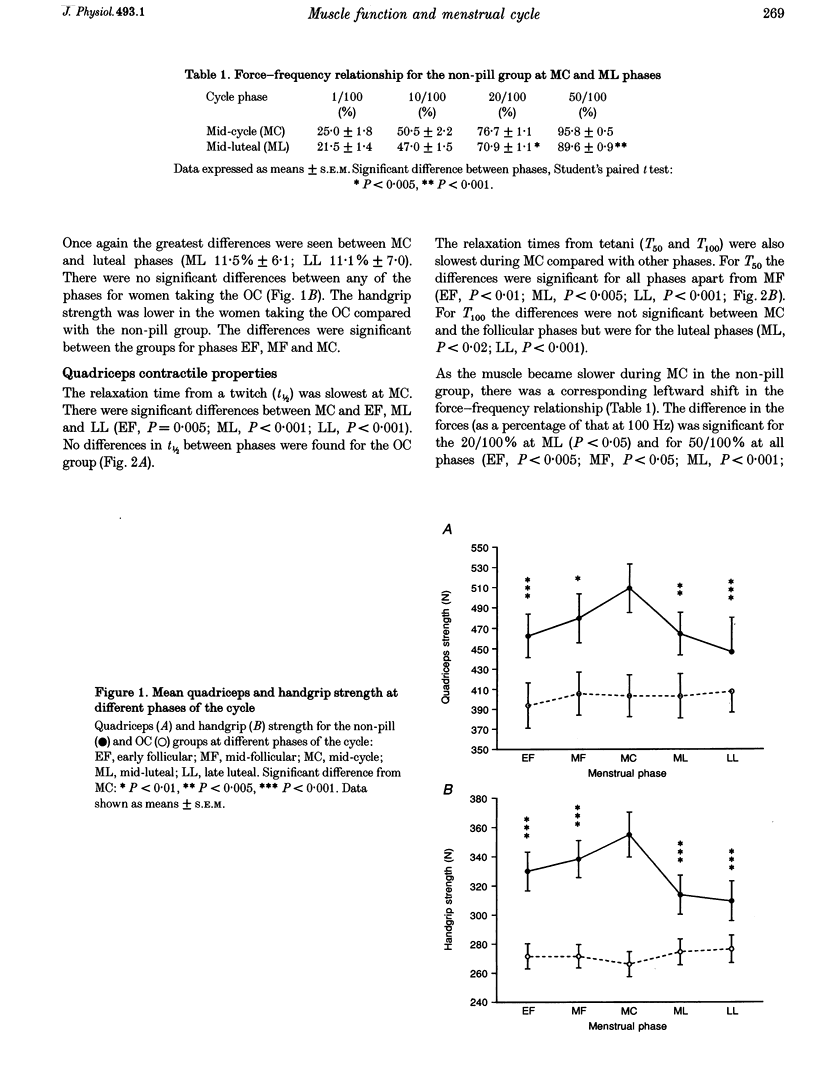
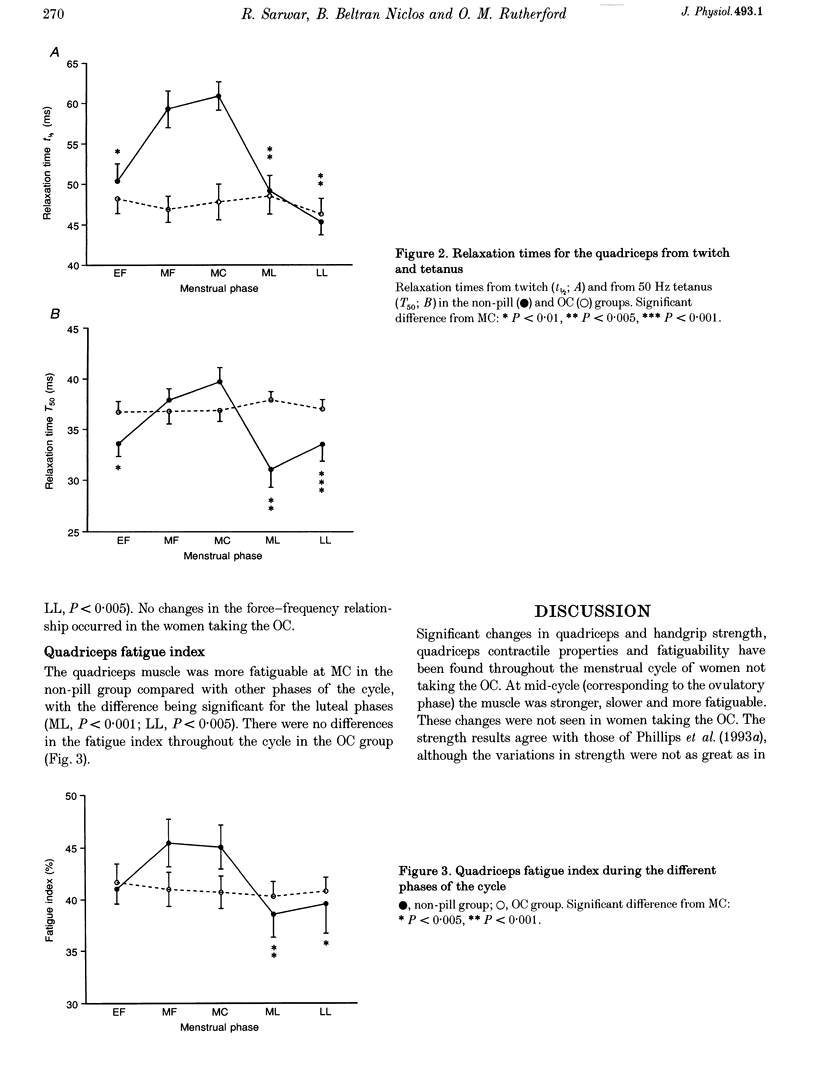
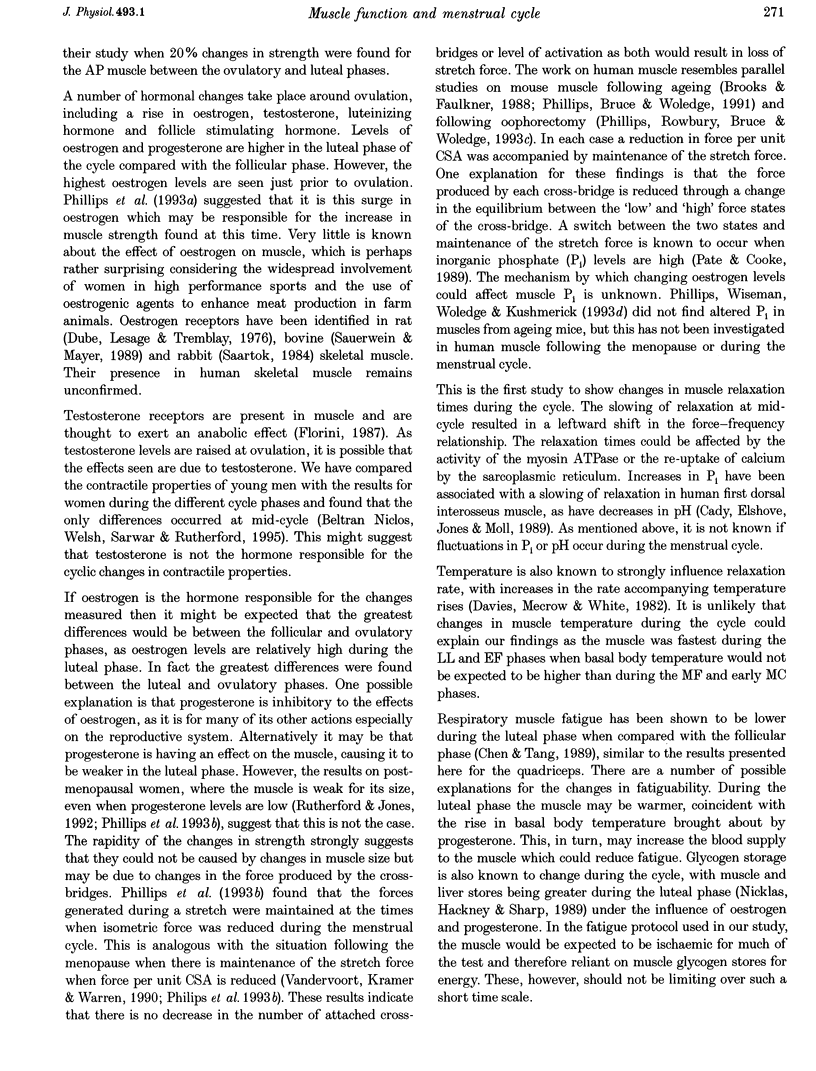
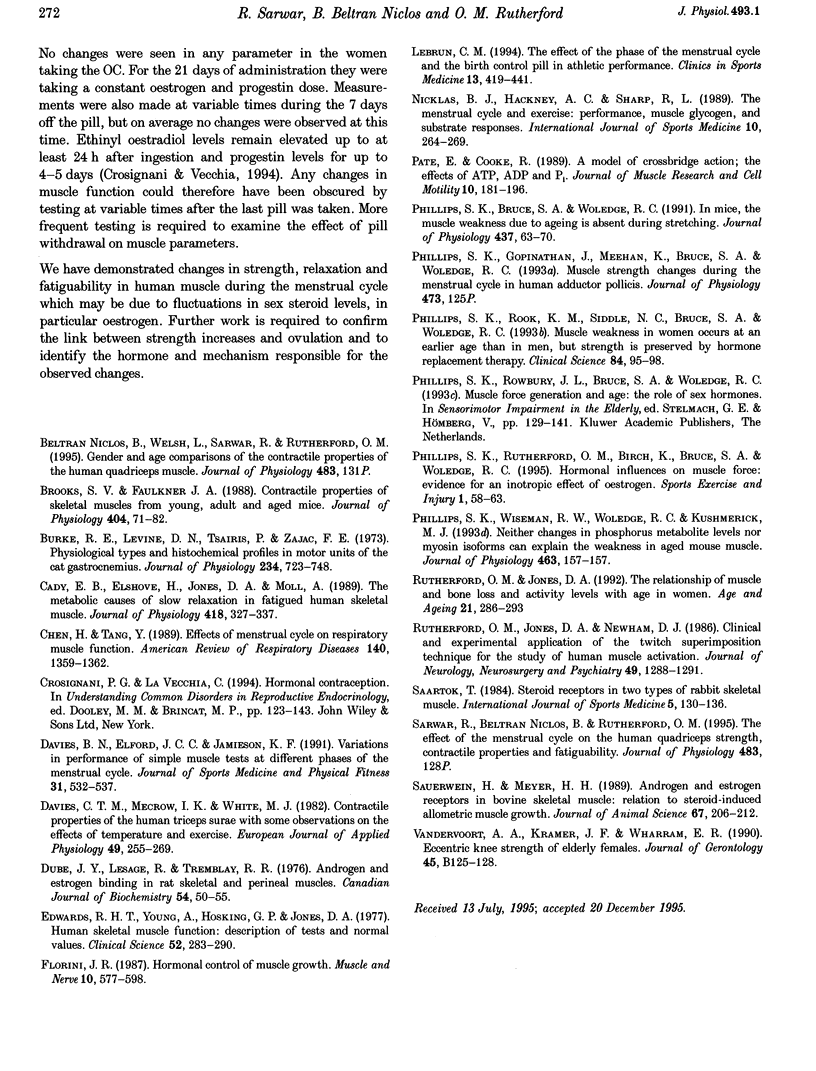
Selected References
These references are in PubMed. This may not be the complete list of references from this article.
- Brooks S. V., Faulkner J. A. Contractile properties of skeletal muscles from young, adult and aged mice. J Physiol. 1988 Oct;404:71–82. doi: 10.1113/jphysiol.1988.sp017279. [DOI] [PMC free article] [PubMed] [Google Scholar]
- Burke R. E., Levine D. N., Tsairis P., Zajac F. E., 3rd Physiological types and histochemical profiles in motor units of the cat gastrocnemius. J Physiol. 1973 Nov;234(3):723–748. doi: 10.1113/jphysiol.1973.sp010369. [DOI] [PMC free article] [PubMed] [Google Scholar]
- Cady E. B., Elshove H., Jones D. A., Moll A. The metabolic causes of slow relaxation in fatigued human skeletal muscle. J Physiol. 1989 Nov;418:327–337. doi: 10.1113/jphysiol.1989.sp017843. [DOI] [PMC free article] [PubMed] [Google Scholar]
- Chen H. I., Tang Y. R. Effects of the menstrual cycle on respiratory muscle function. Am Rev Respir Dis. 1989 Nov;140(5):1359–1362. doi: 10.1164/ajrccm/140.5.1359. [DOI] [PubMed] [Google Scholar]
- Davies B. N., Elford J. C., Jamieson K. F. Variations in performance in simple muscle tests at different phases of the menstrual cycle. J Sports Med Phys Fitness. 1991 Dec;31(4):532–537. [PubMed] [Google Scholar]
- Davies C. T., Mecrow I. K., White M. J. Contractile properties of the human triceps surae with some observations on the effects of temperature and exercise. Eur J Appl Physiol Occup Physiol. 1982;49(2):255–269. doi: 10.1007/BF02334074. [DOI] [PubMed] [Google Scholar]
- Dubé J. Y., Lesage R., Tremblay R. R. Androgen and estrogen binding in rat skeletal and perineal muscles. Can J Biochem. 1976 Jan;54(1):50–55. doi: 10.1139/o76-008. [DOI] [PubMed] [Google Scholar]
- Edwards R. H., Young A., Hosking G. P., Jones D. A. Human skeletal muscle function: description of tests and normal values. Clin Sci Mol Med. 1977 Mar;52(3):283–290. doi: 10.1042/cs0520283. [DOI] [PubMed] [Google Scholar]
- Florini J. R. Hormonal control of muscle growth. Muscle Nerve. 1987 Sep;10(7):577–598. doi: 10.1002/mus.880100702. [DOI] [PubMed] [Google Scholar]
- Lebrun C. M. The effect of the phase of the menstrual cycle and the birth control pill on athletic performance. Clin Sports Med. 1994 Apr;13(2):419–441. [PubMed] [Google Scholar]
- Nicklas B. J., Hackney A. C., Sharp R. L. The menstrual cycle and exercise: performance, muscle glycogen, and substrate responses. Int J Sports Med. 1989 Aug;10(4):264–269. doi: 10.1055/s-2007-1024913. [DOI] [PubMed] [Google Scholar]
- Pate E., Cooke R. A model of crossbridge action: the effects of ATP, ADP and Pi. J Muscle Res Cell Motil. 1989 Jun;10(3):181–196. doi: 10.1007/BF01739809. [DOI] [PubMed] [Google Scholar]
- Phillips S. K., Bruce S. A., Woledge R. C. In mice, the muscle weakness due to age is absent during stretching. J Physiol. 1991 Jun;437:63–70. doi: 10.1113/jphysiol.1991.sp018583. [DOI] [PMC free article] [PubMed] [Google Scholar]
- Phillips S. K., Rook K. M., Siddle N. C., Bruce S. A., Woledge R. C. Muscle weakness in women occurs at an earlier age than in men, but strength is preserved by hormone replacement therapy. Clin Sci (Lond) 1993 Jan;84(1):95–98. doi: 10.1042/cs0840095. [DOI] [PubMed] [Google Scholar]
- Phillips S. K., Wiseman R. W., Woledge R. C., Kushmerick M. J. Neither changes in phosphorus metabolite levels nor myosin isoforms can explain the weakness in aged mouse muscle. J Physiol. 1993 Apr;463:157–167. doi: 10.1113/jphysiol.1993.sp019589. [DOI] [PMC free article] [PubMed] [Google Scholar]
- Rutherford O. M., Jones D. A., Newham D. J. Clinical and experimental application of the percutaneous twitch superimposition technique for the study of human muscle activation. J Neurol Neurosurg Psychiatry. 1986 Nov;49(11):1288–1291. doi: 10.1136/jnnp.49.11.1288. [DOI] [PMC free article] [PubMed] [Google Scholar]
- Rutherford O. M., Jones D. A. The relationship of muscle and bone loss and activity levels with age in women. Age Ageing. 1992 Jul;21(4):286–293. doi: 10.1093/ageing/21.4.286. [DOI] [PubMed] [Google Scholar]
- Saartok T. Steroid receptors in two types of rabbit skeletal muscle. Int J Sports Med. 1984 Jun;5(3):130–136. doi: 10.1055/s-2008-1025894. [DOI] [PubMed] [Google Scholar]
- Sauerwein H., Meyer H. H. Androgen and estrogen receptors in bovine skeletal muscle: relation to steroid-induced allometric muscle growth. J Anim Sci. 1989 Jan;67(1):206–212. doi: 10.2527/jas1989.671206x. [DOI] [PubMed] [Google Scholar]
- Vandervoort A. A., Kramer J. F., Wharram E. R. Eccentric knee strength of elderly females. J Gerontol. 1990 Jul;45(4):B125–B128. doi: 10.1093/geronj/45.4.b125. [DOI] [PubMed] [Google Scholar]


